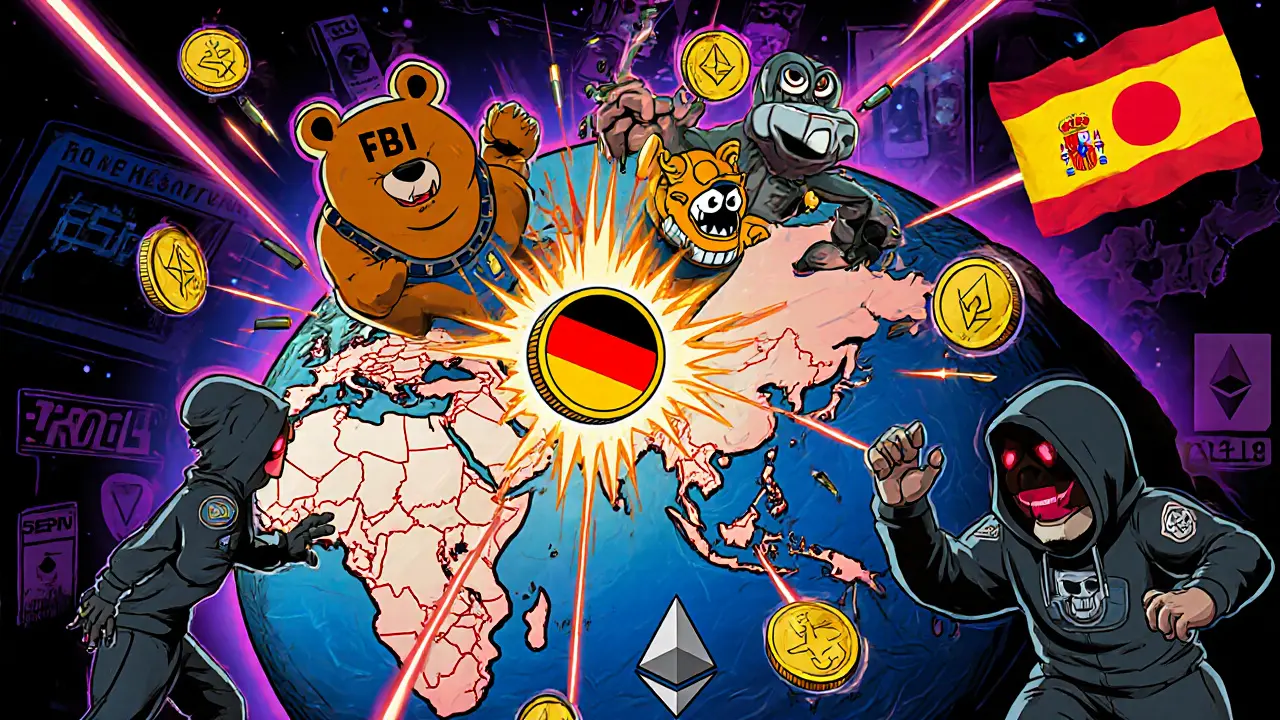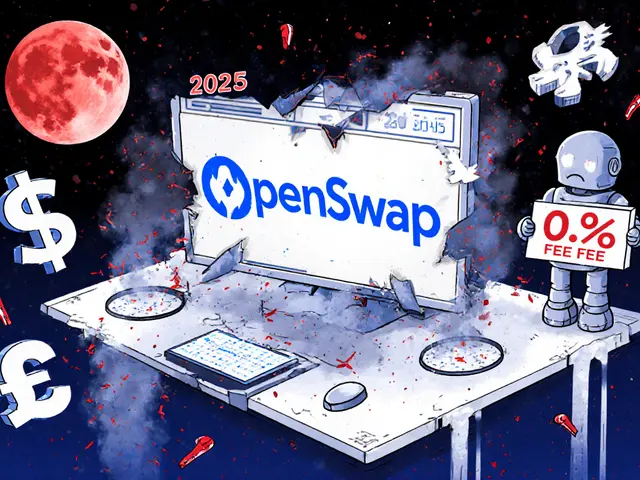Crypto Seizure Comparison Tool
Which Country's Crypto Seizure Approach Are You Exploring?
Select a country to view detailed seizure information.
Crypto Seizure Overview
Current Seizure Value
As of March 2025 (U.S. Strategic Bitcoin Reserve)
Key Enforcement Agencies
FBI IRS DEA Chainalysis
Specialized units with blockchain analytics
When the U.S. government quietly added over 207,000 Bitcoin to a secret digital vault in March 2025, it wasn’t stockpiling for fun. It was building the Strategic Bitcoin Reserve-a new kind of national asset fund made entirely from seized cryptocurrency. This wasn’t just a policy tweak. It was a global signal: governments are no longer just confiscating crypto. They’re holding it, managing it, and treating it like gold.
Across the world, law enforcement agencies are getting smarter about digital asset seizures. From Madrid to Moscow, from Jakarta to Johannesburg, authorities are tracing blockchain trails, freezing wallets, and locking down tokens linked to scams, ransomware, and darknet markets. But the rules? They vary wildly. In some countries, seizing crypto is routine. In others, it’s legally murky-or outright banned.
How Crypto Seizures Work-And Why They’re Different Now
Before 2025, most governments treated seized Bitcoin and Ethereum like cash: sell it fast, get the money, move on. But selling millions of dollars’ worth of crypto all at once crashes prices. That hurts victims. It hurts the market. And it gives criminals a free pass to profit from the chaos.
The U.S. changed that. The Strategic Bitcoin Reserve now holds over $17 billion in forfeited crypto, locked in cold storage. Instead of dumping it on exchanges, the government uses it as a long-term asset. Some of it funds future investigations. Some goes to victims of fraud. Some stays put, waiting for value to rise. It’s a hedge against inflation. A tool for national security. And a quiet bet that Bitcoin will keep growing.
This shift didn’t happen in a vacuum. Courts are now ruling that NFTs, DeFi tokens, and even crypto staking rewards can be seized under existing asset forfeiture laws. You don’t need a new law. You just need to prove the asset came from crime-and the blockchain makes that easier than ever.
Who’s Seizing the Most Crypto? The Top Countries
The United States leads in total crypto seizures-not because it has the most crime, but because it has the most resources. The FBI, IRS, and DEA have specialized crypto units. They work with blockchain analytics firms like Chainalysis and Elliptic to track money flows across thousands of addresses.
But the U.S. isn’t alone. Germany’s Federal Criminal Police Office (BKA) has become one of the most active in Europe, especially in cases involving stablecoin laundering. In early 2025, German authorities froze over $420 million in USDC tied to a single phishing ring targeting German investors.
Japan’s Financial Services Agency (FSA) has seized more than $1.3 billion in crypto since 2023, mostly from unlicensed exchanges. Their approach? Shut down platforms first, then trace funds. South Korea’s National Police Agency uses AI-powered blockchain monitoring tools to flag suspicious wallet activity in real time.
And then there’s Spain. In June 2025, the Guardia Civil, working with U.S. federal agents, took down a massive ransomware operation that had stolen over $300 million in Bitcoin and Ethereum. The operation spanned six countries. The seizure? Over 12,000 BTC. It was one of the largest cross-border crypto takedowns ever.

Where Crypto Crime Is Hitting Hardest
Seizures don’t happen in a vacuum. They follow the crime. And crime follows adoption.
In the first half of 2025, over $2.17 billion was stolen from crypto users worldwide-more than all of 2024. The U.S., Germany, and Japan had the highest number of victims. But when you look at how much each victim lost on average, the picture changes. The UAE, Chile, India, and Israel saw the largest losses per person. Why? Because those countries have high-value crypto users-wealthy individuals, institutional investors, and traders who hold large positions.
Eastern Europe, the Middle East, and Central Asia saw the fastest growth in crypto thefts from 2024 to 2025. Why? Because adoption is rising fast, but regulation isn’t keeping up. In Ukraine, Moldova, and Georgia, crypto is used for everything from remittances to paying salaries. Criminals know that. And they’re targeting it.
Sub-Saharan Africa had the lowest total value stolen-not because people aren’t using crypto, but because most users hold smaller amounts. That doesn’t mean less crime. It means less money on the table.
Legal Gray Zones: Where Crypto Seizure Gets Complicated
Not every country treats crypto like property. Some treat it like gambling. Others treat it like contraband.
In South Africa, the Reserve Bank says Bitcoin has “no legal status.” But the tax office says it’s an intangible asset-and you owe taxes on it. So if you’re caught with stolen crypto, do they seize it? Probably. But can they legally prove ownership? That’s still being debated in court.
Namibia outright bans crypto exchanges and doesn’t allow it as payment. But people still use it. So if someone gets robbed of their Bitcoin there, do the police help? Unlikely. There’s no legal framework to even begin.
Angola? Crypto is legal. No laws against it. But the government tells citizens not to use it. So if you’re hacked, you’re on your own.
Mauritius is the opposite. It has clear rules. Crypto is a regulated digital asset under the Financial Services Act. Exchanges must be licensed. Wallet providers must comply with KYC. And if crypto is stolen? The authorities can freeze it-and the courts will back them up.
This patchwork of rules makes international cooperation messy. A hacker in Russia steals crypto from a user in Canada, sends it to an exchange in Indonesia, and cashes out through a mixer in Turkey. Who has jurisdiction? Who gets the seized funds? That’s where global partnerships like the one between the U.S. and Spain become critical.

The Rise of the Strategic Reserve-and What It Means
The Strategic Bitcoin Reserve isn’t just a vault. It’s a new kind of financial weapon.
By holding onto seized crypto instead of selling it, the U.S. government avoids crashing markets. It also gains exposure to Bitcoin’s long-term growth. If Bitcoin hits $150,000 next year, the reserve grows by billions-without spending a dime.
Other countries are watching. The European Central Bank is studying whether to create a similar fund. Japan’s finance ministry is debating whether to use seized crypto to back future digital yen projects. Even small nations like El Salvador, which holds Bitcoin as legal tender, are considering using seized crypto to fund public infrastructure.
But it’s not without risk. Critics say holding crypto creates conflicts of interest. If the government owns Bitcoin, does it have an incentive to let some crimes slide to protect its holdings? There’s no evidence of that yet. But transparency is now the biggest demand from watchdog groups.
That’s why new U.S. rules require quarterly public reports on the reserve’s size, holdings, and disbursements to victims. Congress is also pushing for an independent auditor to review all seizures.
What’s Next? The Global Push for Clarity
The world is moving toward two things: better tracking and clearer rules.
Blockchain analytics tools are getting faster. AI can now trace a single Bitcoin from a darknet market to a Coinbase wallet in under 30 seconds. Law enforcement is training more crypto-savvy agents. The U.S. Cyber and Emerging Technologies Unit alone has doubled its staff since 2024.
At the same time, countries are finally starting to align. The Financial Action Task Force (FATF) released updated guidance in May 2025, urging all member nations to treat crypto as property for forfeiture purposes. Over 60 countries have already adopted the framework.
What’s next? More joint operations. More shared databases. More standardized legal definitions. And possibly, a global registry of seized crypto assets-so no one can hide funds by moving them across borders.
For users, the message is simple: if you’re holding crypto, assume it’s traceable. If you’re using it legally, you have nothing to fear. But if you’re trying to hide stolen funds? The blockchain doesn’t forget. And governments are learning how to read it.
Can governments really seize my cryptocurrency?
Yes-if they can prove it was used in or obtained through illegal activity. Courts in the U.S., EU, Japan, and other major economies now treat crypto as property under existing asset forfeiture laws. You don’t need a new law. You just need a blockchain trail linking the wallet to crime. If you’re using crypto legally and following KYC rules, your assets are protected.
Which countries are the most aggressive in seizing crypto?
The U.S. leads in total value seized, thanks to its large budget, specialized units, and access to blockchain analytics. Germany, Japan, and South Korea are also highly active. Spain made headlines in 2025 with a major cross-border operation. Countries with strong financial regulators and high crypto adoption tend to be the most aggressive.
Is it legal to hold seized crypto as a national reserve?
The U.S. is the first to formally do this with the Strategic Bitcoin Reserve, and it’s legally grounded in existing forfeiture statutes. The reserve is managed under strict rules: funds must be used for victim restitution, law enforcement, or held as a long-term asset. Other countries are studying the model, but none have fully adopted it yet. Legality depends on domestic law, but the trend is moving toward acceptance.
Why are some countries banning crypto if they can’t even seize it?
Some countries ban crypto because they lack the tools, expertise, or legal framework to regulate or seize it. Namibia, for example, prohibits exchanges but doesn’t have the tech to track wallets. In those cases, banning is easier than building enforcement. But as crypto adoption grows, even these countries are starting to reconsider. The real question isn’t whether to ban-it’s whether to control.
How do law enforcement agencies track stolen crypto?
They use blockchain analysis tools like Chainalysis, Elliptic, and CipherTrace. These platforms map transaction flows across public ledgers. Even if a hacker uses mixers or bridges, patterns emerge. Wallets linked to darknet markets, ransomware payments, or known scam addresses are flagged. Once a transaction is tied to a known criminal entity, law enforcement can freeze it through exchanges or wallet providers that comply with local regulations.
What happens to the crypto after it’s seized?
It depends on the country. In the U.S., most seized crypto goes into the Strategic Bitcoin Reserve. Some is auctioned off to fund victim restitution or law enforcement. In Europe, it’s often liquidated and turned into fiat. In countries without clear rules, it may be held indefinitely or destroyed. The trend, however, is shifting toward long-term holding to avoid market disruption and gain asset appreciation.
Can I get my crypto back if it was stolen and seized?
Possibly. In the U.S., victims of crypto fraud can file claims through the Department of Justice’s Victim Restitution Program. If the seized crypto can be traced back to your wallet and the crime is confirmed, you may receive a portion of the recovered assets-often in fiat, sometimes in crypto. The process takes months, and not all claims are approved, but it’s a real path to recovery.
Are NFTs and DeFi tokens also subject to seizure?
Yes. U.S. courts have ruled that NFTs and DeFi tokens are subject to forfeiture if they’re tied to illegal activity. In 2024, the DOJ seized a collection of NFTs linked to a money laundering ring. In 2025, a DeFi protocol used to launder stablecoins was shut down, and over $80 million in staked ETH was frozen. These aren’t edge cases anymore-they’re standard enforcement actions.






Suhail Kashmiri
This is why crypto is trash-criminals use it, governments seize it, and regular people get caught in the crossfire. No one wins.